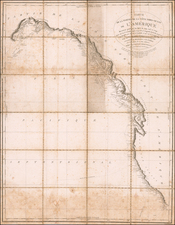Tracking (and Litigating) Water Conservation in the Inland Empire in the 1930s -- Irvine Company Sues San Bernardino Water District
Rare separately published map and infographic, illustrating rainfall and other water related statistics for the San Bernardino Basin in the first part of the 20th Century (1910-1932).
Drawn by G.E. Degerholm, this remarkable graphic was likely developed by the Water Conservation Association (WCA) in connection with its defense of litigation brought by the Irvine Company to restructure "water conservation" practices in the Inland Empire, as they related to the Santa Ana River and its tributary creeks flowing from the San Bernardino Mountains.
The "Water Conservation Association" was formed in 1909 by San Bernardino, Riverside and Orange Counties to address flooding issues and fight water waste, most notably the usage of the Santa Ana River waters and related flooding. Organized by Francis Cuttle of Riverside, the idea was to spread water from the Santa Ana River on the "debris cone" at point where the River entered the east part of the San Bernardino Valley from the mountains, as a means of allowing the water to percolate into the San Bernardino artesian basin, the primary underground water source for well water in the San Bernardino Valley. Over time, similar water conservation plans were developed for other major creeks running from the San Bernardino Mountains, including Mill Creek, Lytle Creek and Cajon Creek.
The disbursement of the water, over time, likely impacted the availability of the water downstream, most notably the lands of Orange County and particularly the Irvine Company, likely impacting the amount of water available for the growing communities of Orange County. Over time, the three counties were apparently at odds on the distribution of the water.
The Association's work seems to have continued until the early 1930s, when its activities were contested by the Irvine Company (and joined Orange County), which filed suit in Federal Court seeking to modify the water spreading activities of the three counties in 1932. The matter came to trial in April 1942 and involved the original Water Conservation Association formed by the three counties, along with East Lugonia Mutual Water Company, City of Redlands, San Bernardino Valley Water Conservation district and the Lytle Creek and Cajon Creek water districts.
The various tables illustrate a number of statistical details relating rainfall, well water and other details, with the main map showing the distribution of wells in the east end of the San Bernardino Valley, from the point it leaves the mountains (top right) to the areas around Colton and San Bernardino.
Rarity
The work appears to be a unique survival.
We were unable to find any other examples in OCLC or elsewhere.









![(California City, California Archive) [Lot of 4 maps related to the early development of California City]](https://storage.googleapis.com/raremaps/img/small/72782.jpg)
![[Fruit Crate Label Advertising Map] Star of California Brand](https://storage.googleapis.com/raremaps/img/small/41396.jpg)

![[ Chinese Voyages To America, etc. ] Memoires De Litterature, Tires Des Registres De L'Academie Royale Des Inscriptions et Belles-Lettres Depuis l' annee M. DCC. XVIII. julques & compris l'annee M. DCC. XXV Tome Quarante-Neuvieme](https://storage.googleapis.com/raremaps/img/small/101296.jpg)
![[ San Francisco and California Coast to Central Baja ] Cote Nord-Ouest De L'Amerique Reconnue par le Cape. Vancouver Ie. Partie . . .](https://storage.googleapis.com/raremaps/img/small/82224.jpg)
